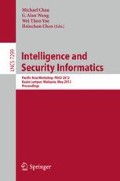Abstract
We concentrate on recognizing persons according to the way they walk. Our approach considers a human movement as a set of trajectories of hips, knees, and feet captured as the person walks. The trajectories are used for the extraction of viewpoint invariant planar signals that express how a distance between a pair of specific points on the human body changes in time. We solely focus on analysis and normalization of extracted signals to simplify their similarity comparison, without presenting any specific gait recognition method. In particular, we propose a novel method for automatic determination of walk cycles within extracted signals and evaluate its importance on a real-life human motion database.
Access this chapter
Tax calculation will be finalised at checkout
Purchases are for personal use only
Preview
Unable to display preview. Download preview PDF.
References
BenAbdelkader, C., Cutler, R., Davis, L.: Stride and cadence as a biometric in automatic person identification and verification. In: 5th International Conference on Automatic Face Gesture Recognition, pp. 372–377. IEEE (2002)
Bhanu, B., Han, J.: Human Recognition at a Distance in Video. Advances in Computer Vision and Pattern Recognition. Springer (2010)
Boulgouris, N.V., Plataniotis, K.N., Hatzinakos, D.: Gait recognition using linear time normalization. Pattern Recognition 39(5), 969–979 (2006)
Cunado, D.: Automatic extraction and description of human gait models for recognition purposes. Computer Vision and Image Understanding 90(1), 1–41 (2003)
Helwig, N.E., Hong, S., Hsiao-Wecksler, E.T., Polk, J.D.: Methods to temporally align gait cycle data. Journal of Biomechanics 44(3), 561–566 (2011)
Tanawongsuwan, R., Bobick, A.F.: Gait recognition from time-normalized joint-angle trajectories in the walking plane. In: International Conference on Computer Vision and Pattern Recognition (CVPR 2001), vol. 2(C), pp. II–726–II–731 (2001)
Wang, L., Ning, H., Tan, T., Hu, W.: Fusion of static and dynamic body biometrics for gait recognition. IEEE Transactions on Circuits and Systems for Video Technology 14(2), 149–158 (2004)
Yoo, J.H., Hwang, D., Moon, K.Y., Nixon, M.S.: Automated human recognition by gait using neural network. In: Workshops on Image Processing Theory, Tools and Applications, pp. 1–6. IEEE (2008)
Author information
Authors and Affiliations
Editor information
Editors and Affiliations
Rights and permissions
Copyright information
© 2012 Springer-Verlag Berlin Heidelberg
About this paper
Cite this paper
Valcik, J., Sedmidubsky, J., Balazia, M., Zezula, P. (2012). Identifying Walk Cycles for Human Recognition. In: Chau, M., Wang, G.A., Yue, W.T., Chen, H. (eds) Intelligence and Security Informatics. PAISI 2012. Lecture Notes in Computer Science, vol 7299. Springer, Berlin, Heidelberg. https://doi.org/10.1007/978-3-642-30428-6_10
Download citation
DOI: https://doi.org/10.1007/978-3-642-30428-6_10
Publisher Name: Springer, Berlin, Heidelberg
Print ISBN: 978-3-642-30427-9
Online ISBN: 978-3-642-30428-6
eBook Packages: Computer ScienceComputer Science (R0)

